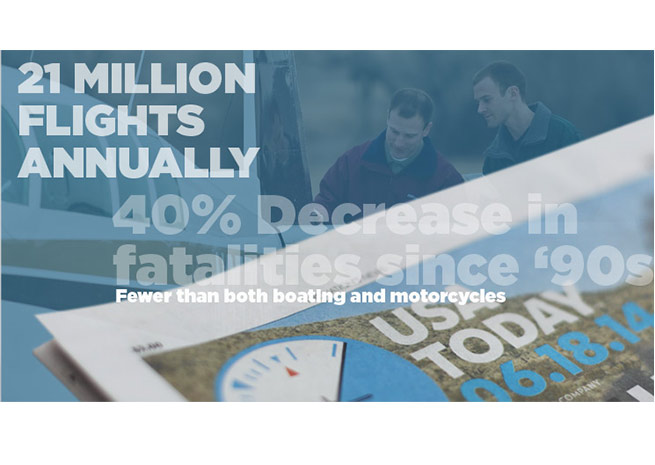
A USA Today story, “Unfit for flight,” published June 18 “gets the general aviation safety record wrong, it ignores efforts by the industry to make general aviation safer, and it violates basic tenets of fairness and accuracy when it comes to good journalism,” AOPA said in response to the article.
The three-part report paints GA aircraft as death traps, pilots as “amateur,” and aircraft manufacturers as villains, and pits pilots against manufacturers. AOPA, the General Aviation Manufacturers Association, and Textron had provided information to the reporter, information that was not included in the sensational, one-sided, inaccurate report.
“The article leads one to believe that general aviation is an unsafe form of transportation, but in truth, general aviation has demonstrated significant progress in safety. According to the National Transportation Safety Board, the number of fatalities has declined by over 40 percent since the early 1990s. Of course mentioning that sort of fact would have undermined reporter Tom Frank’s narrative; you won’t find those statistics in his piece,” AOPA said.
Frank’s article says quite the opposite, calling one fatal accident a “part of a massive and growing death toll from small-aircraft crashes.” The article cites 45,000 deaths in the past 50 years, and specifically calls out 347 fatalities from 1,199 accidents in 2013. However, it conveniently neglects including the total number of operations and flight hours, which AOPA pointed out:
“General aviation is enveloped by a robust safety system that is more extensive than any other recreational activity in the United States. This system addresses everything from aircraft certification to pilot training, aircraft maintenance and flight operations. This results in a general aviation system that provides for 21 million flight hours annually while carrying 170 million passengers per year safely and efficiently.
“In comparison to other forms of recreational transportation, the annual number of fatalities for general aviation is about 30 percent fewer of that of the recreational boating industry, and not even 10 percent of motorcycles.”
The article also blames aircraft manufacturers and the FAA for ignoring safety issues and delaying progress on implementing new safety features on aircraft.
GAMA President Pete Bunce responded with details of the steps aircraft manufacturers and the FAA take to ensure aircraft are safe. The article, he said, “fails to acknowledge the significant progress general aviation manufacturers have made to improve safety.
“Aircraft manufacturers spend significant time and expense to ensure the safety of their aircraft. This process begins with a three-to-six year period in which the manufacturer demonstrates to the Federal Aviation Administration (FAA) that each design meets the applicable regulations. The tightly controlled aircraft design process results in a specific design approval—the type certified design, or TC—which applies only to that particular approved design that can then be produced. If a manufacturer wants to make something different, it must go through another safety review process for approval.”
The article also calls aging aircraft unsafe and says that the “FAA's resistance to some safety features has compounded a major problem with the nation's roughly 220,000 general-aviation aircraft: Many are decades old,” and that “amateur pilots keep propeller-driven airplanes for decades because buying a new one is costly.”
“In 2013, the general aviation industry, including airplane and equipment manufacturers and operators, provided the FAA with extensive recommendations which, when implemented, will expedite the process for the development, certification, introduction and installation of safety enhancing equipment on existing and new aircraft. The FAA has begun the implementation of these recommendations and needs to ensure that all of the recommendations are acted upon,” AOPA said.
In 2013, the House and Senate passed the Small Airplane Revitalization Act requiring the FAA to implement recommendations from the committee by the end of 2015. AOPA is a member of the committee, which is co-chaired by GAMA, and worked on Capitol Hill to educate lawmakers of the importance of passing the Small Airplane Revitalization Act.
“It is clear that Mr. Frank could make no space in his lengthy article for evidence of progress—evidence laid out in an hour-long discussion AOPA had with him last week. Including this information would have undermined his misplaced notion that general aviation is unsafe,” AOPA concluded.


